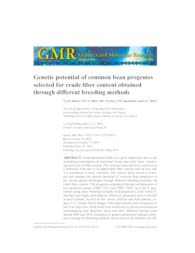Genetic potential of common bean progenies selected for crude fiber content obtained through different breeding methods.
Genetic potential of common bean progenies selected for crude fiber content obtained through different breeding methods.
Autoria: PONTES JÚNIOR, V. de A.; MELO, P. G. S.; PEREIRA, H. S.; BASSINELLO, P. Z.; MELO, L. C.
Resumo: Gastrointestinal health is of great importance due to the increasing consumption of functional foods, especially those concerning diets rich in fiber content. The common bean has been valorized as a nutritious food due to its appreciable fiber content and the fact that it is consumed in many countries. The current study aimed to evaluate and compare the genetic potential of common bean progenies of the carioca group, developed through different breeding methods, for crude fiber content. The progenies originated through hybridization of two advanced strains, CNFC 7812 and CNFC 7829, up to the F7 generation using three breeding methods: bulk-population, bulk within F2 families, and single seed descent. Fifteen F8 progenies were evaluated in each method, as well as two check cultivars and both parents, using a 7 x 7 simple lattice design, with experimental plots comprised of two 4-m long rows. Field trials were conducted in eleven environments encompassing four Brazilian states and three different sowing times during 2009 and 2010. Estimates of genetic parameters indicate differences among the breeding methods, which seem to be related to the different processes for sampling the advanced progenies inherent to each method, given that the trait in question is not subject to natural selection. Variability amongst progenies occurred within the three breeding methods and there was also a significant effect of environment on the progeny for all methods. Progenies developed by bulk-population attained the highest estimates of genetic parameters, had less interaction with the environment, and greater variability.
Ano de publicação: 2015
Tipo de publicação: Artigo de periódico
Unidade: Embrapa Arroz e Feijão
Palavras-chave: Feijão, Hereditariedade, Melhoramento genético vegetal, Phaseolus vulgaris, Variação genética
Observações
1 - Por padrão são exibidas publicações dos últimos 20 anos. Para encontrar publicações mais antigas, configure o filtro ano de publicação, colocando o ano a partir do qual você deseja encontrar publicações. O filtro está na coluna da esquerda na busca acima.
2 - Para ler algumas publicações da Embrapa (apenas as que estão em formato ePub), é necessário ter, no celular ou computador, um desses softwares gratuitos. Sistemas Android: Google Play Livros; IOS: iBooks; Windows e Linux: software Calibre.
Acesse outras publicações
Acesse a Base de Dados da Pesquisa Agropecuária (BDPA) para consultar o acervo completo das bibliotecas da Embrapa.

